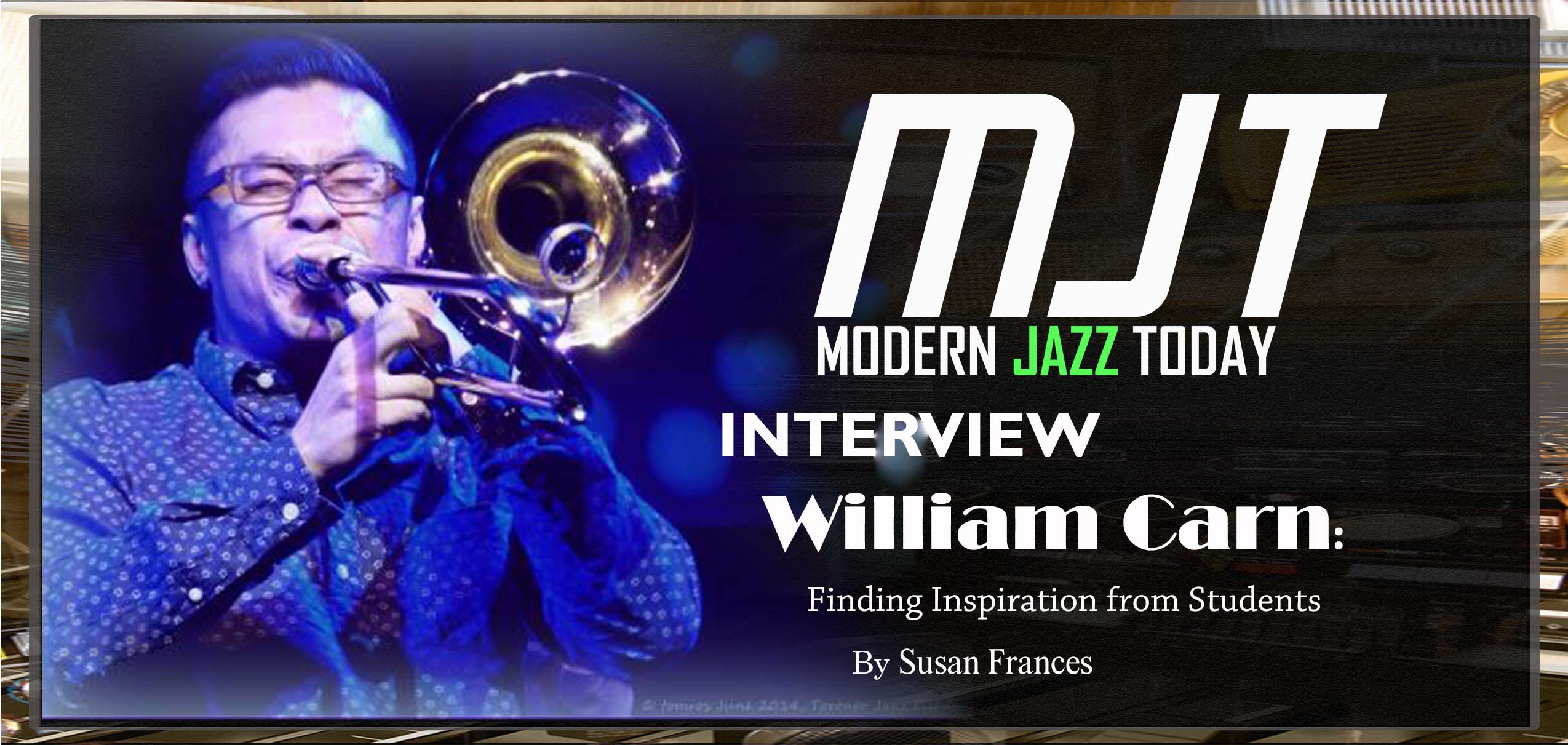William Carn: Finding Inspiration from Students
by Susan Frances

Born in Hong Kong, Carn’s family migrated to Canada via Costa Rica. Creating a home in Canada, he has taught in music programs throughout Canada for such distinguished institutions as the University of Victoria, University of Saskatchewan, University of Regina, Capilano College, Grant MacEwan College, and Mohawk College. In addition, he is a regular faculty member and instructor for the University of Toronto Jazz Studies program.
While many contemporary artists cite jazz legends of the past as their influencers, in Carn’s case, he proclaims, “I would say the biggest way that being an educator has influenced my writing style is the exposure to different styles of music via students that I might have missed. For instance, some of the more modern influences on my current recording Choices come directly from artists that I listen to as a result of some of my students.”
Carn’s 2022 recording Choices marries traditional straight-ahead jazz with sonic effects and passages of shimmery pixilation. The union is a stirring mixture of expressive motifs and scintillating atmospherics. Tracks like “The Gift,” “Breathe In,” and “Breathe Out” are laden with liquid fire, producing floating emanations and eclectic soundscapes that leave the listener feeling inebriated. Likewise, “Get Up” has a funky R&B vibe, while “Heroyim Slava” exudes a reverent ambience, bolstered by lofty trombone wails and trussed in circling sonic effects.
“All the compositions on Choices,” Carn regards, “reflect important moments during the 2 and a half years it took to make the songs.”

“When you are used to performing and creating regularly,” he observes, “the pandemic gutted a lot of the artistic community. I knew that I needed to keep making music even if it was just for me and my friends.”
He explains, “Choices began as demo songs made in GarageBand, with which I applied to the Canada Council for the Arts to get funding to move forward. Now I use Logic and other software to fuel my new focus.”
“I made most of the base tracks on my keyboard at home,” he notes, “before sending them to friends to record their parts from their home studios. HiFilo (aka Todd Pentney) played keys on two tracks, ‘Inertia’ & ‘Get Up,’ and was vital in helping me merge all of these sounds together.”
Supporting Carn on Choices are a handful of guest musicians whom he has performed with or fortuitously encountered throughout his teaching and recording experiences. The musicians include HiFiLo on keyboards, William Sperandei on trumpet, Kelly Jefferson on tenor saxophone, Jesse Ryan on alto saxophone, Ernesto Cervini on drums, Larnell Lewis on drums, and Davide Direnzo on drums.
The track “The Inertia Of Complacency” is one arrangement on Choices that uses several of Carn’s supporting musicians. He reveals, “The song was originally conceived for the jazz sextet Turboprop, of which I’m a member. I asked Todd Pentney (aka HiFilo) to play the keys and later added Ernesto Cervini, leader of Turboprop, on drums, as well as Kelly Jefferson on sax, and William Sperandei on trumpet. All remotely recorded from our own homes.”
He recalls, “The song was conceived after some conversations with people where I was reminded that a lot of people complain about things but do little to resolve their dissatisfactions. I got fed up myself, so this was when I composed this song. For me, this falls in the musical therapy component of composing.”

Carn recollects, “I met Jesse Ryan while he was a student at Humber College. I taught at Humber for 16 years and had the pleasure of leading an outreach ensemble composed of exceptional students from the program. We would perform in Toronto public and high schools for approximately 2-3 weeks at the end of the school year.”
“Jesse immediately caught my attention,” he admits, “not just for his playing, but also for how maturely he handled the whole gig. I’ve watched Jesse progress to making his own Juno-nominated recording, and I enjoy the energy and spirit that he exhibits. It’s so gratifying to see students develop their own careers and eventually become colleagues.”
Carn adds, “The track ‘Get Up’ also features the amazing talents of HiFilo on keys, William Sperandei on trumpet, and Larnell Lewis on drums.”
A proponent of collaborative environments, William Carn’s release Choices is just one illustration of how he immerses himself in the collaborative experience. Previously, Carn, as he mentioned, was a member of the jazz collective Turbopop. He has also enjoyed being a part of the collective environments of Run Stop Run, the William Carn Quintet, and Carn Davidson 9.
“Before Run Stop Run,” he shares, “I led the William Carn Quintet (WCQ) for about 5 years. We made 2 recordings, which I’m very proud of, but I realized that solely composing, booking, grant writing, and leading the group was taking its toll on me.”

“This change was exactly what I needed at that time,” he attests. “While the quintet was more in the modern jazz/acoustic vein, RSR was an electric jazz quartet. I firmly believe that change is a good thing.”
Accompanying Carn in Run Stop Run is Don Scott on guitar, Jon Maharaj on bass, and Ethan Ardelli on drums. “These 3 wonderful musicians,” he cites, “are all younger than me.”
He chronicles, “At the time, Jon Maharaj had just joined the William Carn Quintet for a year or two. He had been on the road with my group so I knew he was a good fit musically and personally. Ethan Ardelli was a gifted young drummer that I had the opportunity to play with in Toronto. He, too, was super fun to hang with musically and personally. Lots of laughs. I had met Don Scott while being a side-person in a group named Vertigo, led by bassist Michael Herring. Don is a beautiful writer and player, so I wanted to try playing with him in a smaller musical situation.”
In 2012, Carn and his wife Tara Davidson formed Carn Davidson 9 or CD9. Their latest recording in 2021, The History of Us, is a collective endeavor that offers musical renderings, emotive narrations, and sonic impressions about family, migration, love, and loss.

“Both of us were discussing our own next moves one morning,” he remembers, “when I told her I had a vision for a large chamber ensemble inspired by John Scofield’s album Quiet. That recording featured a wind ensemble that provided a lot of the harmonic duties that a pianist would usually supply. Thus, we decided to form a chordless jazz Nonet. That meant that the winds would be playing more, but the sound of the group would be different from the usual ‘big band’ sound.”
“We didn’t know if our writing styles would complement each other,” he questioned, “but it quickly became evident that we were onto something. We chose some of our favourite musicians in Toronto to be a part of the ensemble.”
“CD9,” he illuminates, “in its current form includes Tara Davidson (woodwinds), Kelly Jefferson (woodwinds), Shirantha Beddage (woodwinds), Jason Logue (trumpet), Kevin Turcotte (trumpet), William Carn (trombone), Christian Overton (bass trombone), Andrew Downing (double bass), and Ernesto Cervini (drums).”
While discussing CD9’s recording, The History of Us, he reflects, “All Canadian families were immigrants at some point with the exception of the aboriginal peoples of these lands. As we were looking at writing our 3rd album for CD9, Tara and I both reflected on what this meant for our own journeys as Canadians. Tara decided to write a suite of music that consisted of a series of ‘love letters’ to her parents and family.”
“My own story is very different,” he imparts, “as I’m a first-generation immigrant to Canada. I decided to try to musically document my family’s journey from Hong Kong to Costa Rica and eventually to Canada. This album has been a truly personal journey for us both.”
His choice to employ the jazz palette to express his personal journey and thoughts was fostered at an early age, as he purports, “My passion for jazz music was ignited by my high school music teacher. Despite being a classically trained flautist, she had a profound love for all genres of music and regularly introduced us to various recordings. She continues to be a great source of inspiration for me, particularly when it comes to teaching. I strongly believe in fostering curiosity and setting high expectations for my students.”

“I had similar results with every other instrument,” he recounts, “I attempted except for the trombone, which produced a rich and full sound. It seemed as though the trombone had chosen me. With a fear of failing music class and some natural ability, my decision to play the trombone became an easy one.”
“I started writing my own songs,” he ascertains, “as soon as I figured out how chords worked on the piano. I would play a chord and start singing melodies. It wasn’t until later that I realized composing allowed me to express music in a way that playing the trombone could not. Composing also allowed me to create frameworks for improvisation and practice harmonic and rhythmic challenges. For me, composing is like a form of musical therapy.”
He asserts, “I’ve accepted what my strengths are as a musician, and I’m not afraid to express them. I am a bit of an introvert, so performing in public used to bring immense anxiety. I am now more able to stay in the moment when making music, be it composing or performing. I suppose I’m the happiest I’ve been as a musician than in the past. I think that was a big lesson from the pandemic – perspective and gratitude.”
When he isn’t working on his music, William Carn confesses, “I love to stay active and run or inline skate. This is a lifelong passion. Tara and I also love to travel and explore foods and cultures that take us out of our comfort zones. Stay inquisitive!”
His nature to be inquisitive and curious has enabled William Carn to look beyond familiar jazz legends and to embrace new ideas, ones that are relevant to the modern generation. Whether he is influenced by compositions created by his students or tracking music that his students gravitate towards, he does not fear to venture into the non-traditional jazz domain of eclectic soundscapes and atmospheric effects. Refusing to be bound by a comfort zone or complacent to follow a set of tracks that have already been laid down, Carn is an unique artist who thrives in a collective environment.
About Susan Frances:






No Comments